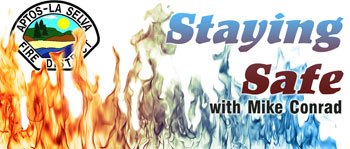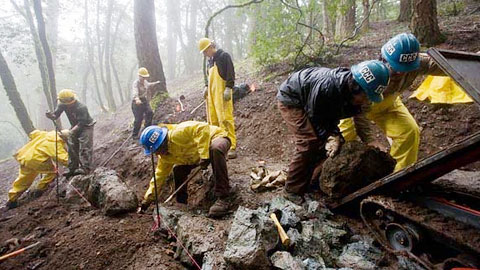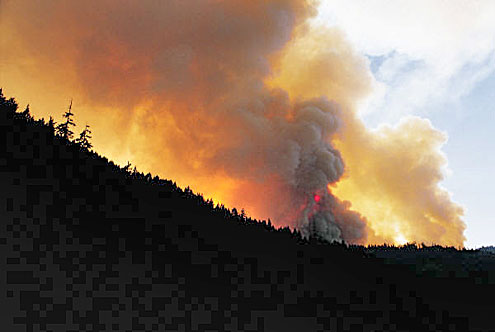By Mike Conrad, Aptos La Selva Fire Protection District
 I have written a lot about wildland fire preparedness. Let’s face it, the most important thing we can do is take steps to prevent or minimize the fire risk to your property. But let’s take it to the next step; you are faced with a wildland fire that is threatening your home! What do you do?
I have written a lot about wildland fire preparedness. Let’s face it, the most important thing we can do is take steps to prevent or minimize the fire risk to your property. But let’s take it to the next step; you are faced with a wildland fire that is threatening your home! What do you do?
The first thing you need to determine is how close is the fire? How much time do you have? If the fire is some distance away and you have been made aware of it by local news reports or neighbors, start thinking about what you will need to do if your are required to evacuate. Review your evacuation checklist; make sure your emergency supply kit is in your vehicle. Round up your pets so you have quick access to them if you need to evacuate.
 Consider gathering up flammable items outside your home. Place loose items like patio furniture, toys, trashcans, etc. inside. Move larger items like BBQ’s, small woodpiles and other combustible items away from your house. Back your car into the driveway and keep your keys with you in the event you must leave quickly. If you have large animals, start thinking about how you will protect them or evacuate them. Prepare truck and trailer if you plan on removing your large animals, and have food and water available for them. Go through your home and close all doors and windows. Remove any lightweight window coverings and move furniture away from the windows.
Consider gathering up flammable items outside your home. Place loose items like patio furniture, toys, trashcans, etc. inside. Move larger items like BBQ’s, small woodpiles and other combustible items away from your house. Back your car into the driveway and keep your keys with you in the event you must leave quickly. If you have large animals, start thinking about how you will protect them or evacuate them. Prepare truck and trailer if you plan on removing your large animals, and have food and water available for them. Go through your home and close all doors and windows. Remove any lightweight window coverings and move furniture away from the windows.
If you receive a notice of voluntary evacuation, be sure the above items have been dealt with. Plus, put your plan in place for the removal of your large animals. Make sure you have gathered your go kit that contains your vital papers and documents. Load those few, must-have items into your vehicle. Seal attic vents and crawlspace vents with precut plywood if it’s safe for you to do.
 Connect garden hoses to outdoor spigots around your house and place a ladder near the front of the house to the roof. Firefighters will be able to utilize your garden hoses and ladder to quickly extinguish small fires when they arrive. Turn off your propane at the tank or your natural gas at the meter. Leave the electricity on and keep a porch light or other light visible to the street on so firefighters can see it through the smoke or at night. As you leave your home leave a door unlocked so firefighters can quickly gain access inside your home to extinguish any fires.
Connect garden hoses to outdoor spigots around your house and place a ladder near the front of the house to the roof. Firefighters will be able to utilize your garden hoses and ladder to quickly extinguish small fires when they arrive. Turn off your propane at the tank or your natural gas at the meter. Leave the electricity on and keep a porch light or other light visible to the street on so firefighters can see it through the smoke or at night. As you leave your home leave a door unlocked so firefighters can quickly gain access inside your home to extinguish any fires.
Your home is now as ready as it can be to withstand a wildland fire. Your preparedness and providing defensible space along with pre-evacuation steps can make a huge difference in the safety of your property. Before driving away, please don’t turn on sprinklers in your lawn or on your roof. This will often greatly reduce water pressure and can interfere with firefighting operations.
If you are given a mandatory evacuation notice, law enforcement may also provide you with a time frame like 10 or 20 minutes. Prioritize the evacuation list and concentrate on doing only the most important items according to the timeline provided. Always follow evacuation recommendations often we see people who wait until the very last second to leave and when they finally do, especially on narrow roads, they impede access for fire fighting equipment.
We will always try to provide you with as much lead time as possible. However, each wild fire is different and can spread with incredible speed so if at any point you feel you are no longer safe, EVACUATE.
•••
For more information please visit the Cal Fire website at www.readyforwildfire.org



